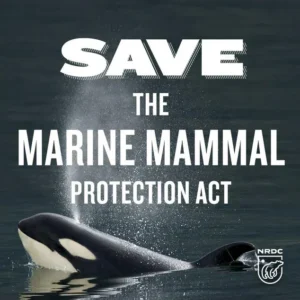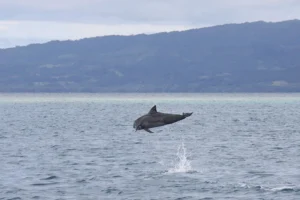PROTECTION OF MARINE MAMMALS
IN INTERNATIONAL LAW
Source: Jus Corpus Law Journal
 Environmental protection is a matter of utmost urgency and significance, and the principal ingredient for the deterioration of aquatic and marine environments is the pollution caused due to the negligence of humans.
Environmental protection is a matter of utmost urgency and significance, and the principal ingredient for the deterioration of aquatic and marine environments is the pollution caused due to the negligence of humans.
Each year about 8 million tons of plastic is dumped into the oceans and seas, and marine animals including whales, turtles and 700 other marine species become victims of undesirable death caused due to the ingestion of plastic.
Various amendments and laws had been established for the protection of marine flora and fauna. The government of India derives power for the protection of marine species from the Maritime Zones of India Act 1976.
PROTECTION OF MARINE MAMMALS – Who are marine mammals?
Aquatic mammals are varied categories of mammals that reside and depend upon the bodies of water for their existence. Marine mammals are warm-blooded mammals who breathe through their lungs, to nurture the young ones they even produce milk. Marine mammals are segregated categorically: Cetaceans (whales, porpoise, Dolphins), Pinnipeds (seals, walruses and sea lions), Sirenians (dugongs and manatee) and Marine Fissipeds (Polar bear and sea otters).[1]
PROTECTION OF MARINE MAMMALS – DANGER FOR THE MARINE MAMMALS
Although there are several rational behind the extinction of marine mammals, extinction caused by the climate is unusual, on the other hand, overexploitation throughout the decade might be one of the possible reasons for the extinction of marine mammals.
The low and high emission of greenhouse gases scenarios sequels the vulnerability of marine mammals increased in the 21st century. There are various threatened species that displays unique combinations of features traits such as the dugong (Dugong Dugon) and north pacific right whale (Eubalaena japonica).
Global warming had a diverse impact which might cause disproportionate loss to the marine diversity and profound effect on the worldwide future of the marine ecosystem. Ingestion of plastic or plastic-based matters and the unusual disturbance in climate change are also major concerns for the marine ecosystem.[2]
PROTECTION OF MARINE MAMMALS – MAJOR PROBLEMS AND CONCERNS
The major problem concerned with marine mammals is their protection and conservation of their lives and ecosystem because the species are coming into the list of endangered species and are going to extinct after some time.
There are several rational behind this the problem of overfishing and trading, the problem of pollution in the seas and oceans and the climatic changes for which there are certain rules and regulations which are constituted by the government for conservation.
FRAMEWORK OF LAWS AND ACTS FOR THE CONSERVATION AND PROTECTION OF MARINE MAMMALS
The government of the united nation had formulated various acts and laws for the conservation of marine species and protection of marine flora these are as follows:
- Marine mammal protection act
The protection for the marine mammals the act was enacted on October 21, 1972, named the Marine Mammal Protection Act (MMPA), it ensures that all the marine mammals are protected under MMPA. The awareness between the scientists and the public about the decline of some marine species caused by the Human-made the congress passed the legislation. The power is shared between three entities for the better implementation of MMPA.
- For the protection of sea lions, seals, porpoises, dolphins and whales the responsibility is undertaken by NOAA.
- The preservation and protection of walrus, manatees, polar bears and sea otters are provided by U.S Fish and Wildlife Service.
- The furnishing of new international policies and actions of federal agencies concerning marine ecosystems.
The act incorporates two amendments the amendment of 1992 and the amendment of 1994 the former encompasses the title IV which commands the emergency reaction to the marine mammal’s sufferings, observing the health of marine mammals, the latter furnished the definition of the word “harassment” considered as a prohibited activity.[3]
PROTECTION OF MARINE MAMMALS – MAGNUSON-STEVENS ACT
The Magnuson-Stevens fisheries conservation and management Act (MSA) passed in the year 1976, considered as central legislation that controls the management of marine fisheries in United States waters. Emphasizes majorly upon long term biological and economic sustainability and its objectives are:
- Prevention of overfishing
- To rebuild the stocks overfished
- Enhance long term social and economic benefits
- Ensures safe supply of seafood
In 1996 with the passage of the sustainable fisheries act and the reauthorization of the MSA act in 2007 these are the two significant changes made by congress.[4]
PROTECTION OF MARINE MAMMALS – ENDANGERED SPECIES ACT
In 1973 congress passes the endangered species act after recognizing that the aesthetic, educational, ecological heritage and scientific value to mankind and nation. After the comprehension of the existing situation, it was well understood by the government that mammals would become extinct if they are not protected. The federal government had certain responsibilities under ESA.
- Threatened species – these are more probable to be endangered in the future.
- Endangered species – species that are said to be in danger of extinction throughout all the significant portion of their range.
- Critical habitat – some of the specific areas of critical habitat are
Outside the geographical area inhabited by the mammals and the area is considered as an essential area for the conservation by the agency.
Inside the geographical area inhabited by the mammals which consist of the biological and physical features crucial for the protection, and those features for the conservation may require special protection.[5]
PROTECTION OF MARINE MAMMALS – RECOMMENDATIONS
 To reduce overfishing the government can shift to the approaches which are helpful for the management of fisheries and ecosystem-based approaches aiding overall mortality rates of fishes. The formulations for the conservation should be made on the ground of sustainability and customized accordingly after keeping into consideration the requirement of that particular locality and habitation.
To reduce overfishing the government can shift to the approaches which are helpful for the management of fisheries and ecosystem-based approaches aiding overall mortality rates of fishes. The formulations for the conservation should be made on the ground of sustainability and customized accordingly after keeping into consideration the requirement of that particular locality and habitation.
The aim of the acts should be not to jeopardize a broad category of goods and services from the marine ecology while facilitating the revenue, recreation and food to the human inhabitants can be done by reconstructing biological communities, biological diversity and biological productivity at a higher level.
Al the legislation for the conservation and protection of mammals are concerned with conservation which is the second stage the primary stage for their inhabitation is pollution-free environment and ecology. Overcrowding in the beaches should be restricted to areas that are prone to animal injury or the beaches where there are abundant marine mammals inhabiting should not be designated as a public place since mammals should be free and there are several instincts where human beings had caused harm to the species.
PROTECTION OF MARINE MAMMALS – CONCLUSION
Human activities being coastal development and overpopulation surrounding the beach results in the ostentatious habitation for the marine mammals, not standing up to the standards for habitation.
Some species and marine organisms have been the victim of overfishing and trading ending up becoming endangered or extinct species. Fishing is not only connected to the exploitation of the species but they are also linked with the ecology and mammals ecosystem.
The excessive emission of greenhouse gases plays a significant role in expanding the horizon of global warming. The conservation laws constituted by the government are shielding the sea animal but it’s time for the people to be aware of nature, ecosystem and ecology for their conservation so that we can furnish our future generation with a good and healthy environment.
Author(s) Name: Shivi Kanskar (National University of Study and Research in Law, Ranchi)
References:
[1] ‘Marine Mammals’ (Noaa.gov, 2021) <https://www.noaa.gov/education/resource-collections/marine-life/marine-mammals> accessed 06 October 2021
[2] W.W.F, ‘Plastic In Our Oceans Is Killing Marine Mammals’ (wwf.org.au, 2021) <https://www.wwf.org.au/news/blogs/plastic-in-our-oceans-is-killing-marine-mammals> accessed 06 October 2021
[3] J .biskowski l, ‘Marine Mammals Protection Act (1972) | Encyclopedia.Com’ (Encyclopedia.com, 2021) <https://www.encyclopedia.com/environment/encyclopedias-almanacs-transcripts-and-maps/marine-mammals-protection-act-1972> accessed 6 October 2021
[4] ‘Magnuson-Stevens Fishery Conservation and Management Act’ (NOAA, 2021) <https://www.fisheries.noaa.gov/resource/document/magnuson-stevens-fishery-conservation-and-management-act> accessed 07 October 2021
[5] ‘Endangered Species Act’ (NOAA, 2019) <https://www.fisheries.noaa.gov/resource/document/magnuson-stevens-fishery-conservation-and-management-act> accessed 08 October 2021